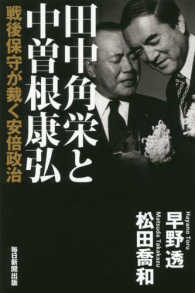- ホーム
- > 洋書
- > 英文書
- > Politics / International Relations
Full Description
Over the last two centuries, Europe has developed various forms of political representation from which democratic parliamentary systems gradually emerged. This book unravels the conditions, scale and impact under which political participation of common burghers and peasants emerged.
Political participation in Europe before the Revolutions moved away from the traditional focus on 'Three Estates' which has often blurred the interpretation of popular participation's role in societies. This book instead examines Europe's key political variants such as high levels of commercialization and urbanization, combined with a balance of powers between competing categories of actors in society controlling relatively independent resources which lead to political participation forming across the continent. Instead of starting from any ideal type of political participation, this book focuses on the variation through time and space, its composition and activity, helps to explain the functions particular institutional settings fulfilled. The time frame 1100-1800 sheds light on the long-term evolutions such as institutional inertia and processes of oligarchizing. To reveal a correlation of economic and demographical growth with the claim of rising social classes to voice their interests. It also points to the opposite tendency: the formation of fiscalmilitary monarchical states.
This book is essential reading for those interested in the formation of Europe's political structures and students of premodern political history.
Contents
1 Historical roots of political voice
Voice and representation
A unique achievement
Continuity? 9
The state of research
Terminology
Theoretical points of departure
Political participation today
This book
2 The playing field is demarcated: Communities and political landscapes
Increasing differences in development
The geographic environment
The formation of political units from a dominant core
The imperial obsession
Alliances of free communities
Coasts, rivers and land masses
The political geography
The playing field
3 The players: The formation of political communities
Estates and their representation
The first estate: the clergy
The second estate: the nobility
Peace movements
Precedence
Concentration of power
Counsel and action
England: the early kingdom
Dynastic wars, bad kings and rebellious barons
Balances of power: Catalonia and Aragon
Dynastic discontinuity
Castile and León
Brabant and Castile
The leading actors
4 Game changers: The third estate makes itself heard
The Italian polyarchy
The astonishing North
The social composition of the Tuscan population
The Papal States
The South
Balances of power
Popular sovereignty in Flanders
Commercial interests
Peasants' voice
The common concern for water management in the Low Countries
Core concepts in the political debate
The triangular relationship: prince, nobility, cities
5 Within the lines: Institutionalized political voice
The vulnerability of princes
The Iberian cortes and Languedoc
Abuse of power and tyranny in England
Political voice on war
Representation of the land?
City leagues in the German realm
The microcosm of the Low Countries
From the Meuse region urban league to the land of Liège
The first socio-political revolution: Flanders
From city leagues to the Brabant constitutional tradition
Estates and princely ambitions
Contrasts
Expansion and emancipation
6 Spectators invade the pitch
The first religiously inspired revolution: Bohemia
The bourgeois revolution in the Low Countries
Church and religion as sources of division
The first sovereign popular representation
Religious polarization in the German realm
Elective kings and regional power in central Europe
Poland
Hungary
Swiss Confederation
Seizure of power by the privileged in France
Republics among monarchies
The Reformation as catalyst
7 Distribution of gain and loss
Societies in figures
Numbers of people and concentrations
Composition of the population
Forms of aristocratic rule in central and eastern Europe
Balances of power in the Holy Roman Empire
A dramatic case: Saxony
Estate members as brokers in the French periphery
The subjugation of Catalonia and the 'long sleep' of Iberia
Conclusion
8 The champions and the excluded
Sovereign republics
Revolution turning into oligarchy: the United Provinces
England and the United Kingdom: the monarchical republic
The bloody road to a constitutional monarchy
The consolidated Parliament
Sweden, a separate case
The formative period
Royal voluntarism and parliamentary opposition
Political parties
Colonies and the other excluded
Ireland
North America
Ascending and descending power
9 Conclusions: Participation versus Effectiveness
A dash of political anthropology
Phases of expansion and contraction
Political voice? Concerning what? The developmental phase, 1100-1350
Consolidation and trials of strength 1350-1600
Constitutional representation or fiscal-military monarchy, 1600-1848
The fundamental dynamics
Emancipation and stagnation
Representation from below
State power
Institutional inertia
The continuity of political cultures
General bibliography, Index








